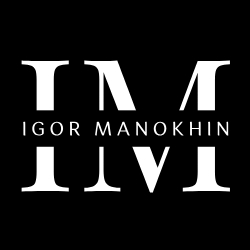
Manokhin Igor
✪ Rehabilitation coach of international level, specializing in motor patterns. Author of a rehabilitation training methodology.
✪ Acting Head of the Department of Biomechanics and Postural Physiology, Russian Academy of Medical and Social Rehabilitation, Moscow.
✪ Participant of scientific and practical conferences, author of methodical literature "How to learn to walk Correctly", "Pozno-tonic reactions - the key to true Movement and Health", co-author of the book "Myofascial Circuits: essays on postural control".
✪ Higher Education: BA in Physical Education, with a minor in Athletic Gymnastics, Udmurt State University (UdSU), Russia (2000–2005)
✪ Additional Professional Education: Diploma in "Physical Rehabilitation and Recreation", Russian Academy of Medical and Social Rehabilitation (RAMSR) in Moscow (2019–2020)

Certificate of Honor from the Government of the Udmurt Republic
The Certificate of Honor from the Government of the Udmurt Republic is established to recognize the special merits of citizens, labor collectives of organizations, public associations operating in the fields of industry, economy, agriculture, industrial and civil construction, science, culture, arts, sports, education, healthcare, state construction, charitable activities, ensuring legality, law and order, protection of the rights and freedoms of citizens, as well as achievements in work and other merits before the Udmurt Republic
World champion in bench press in the weight category up to 100 kg
By versions GPA/GPA-D/IPO/IPO-D/SPR
Russia, 2020
Russia, 2020
April 15, 2023, was my debut at the Open XXVIII Championship of Russia in weightlifting in the senior age groups, which took place in Bugulma
In the category up to 102 kg (M 40+), I became a silver medalist and bronze medalist in the overall standings, achieving my best kilograms in total. My personal record in Power Snatch is 125 kg, in Push Jerk is 145 kg, and my personal record in total is 270 kg.
Emotions are off the charts! Thanks to all the competition organizers, judges, presenters, athletes, and assistants for the high level of the competition - it was a real celebration of strength and will!
Emotions are off the charts! Thanks to all the competition organizers, judges, presenters, athletes, and assistants for the high level of the competition - it was a real celebration of strength and will!

In 2023 the Bodybuilding Federation of the Udmurt Republic will be 35 years old. In this regard, I would like to express my special gratitude to Oleg Pogodin, President of the Federation, for the development and popularization of this sport in our republic.
My path of bodybuilding began in 2000, when I entered UdSU at the Department of Physical Education, majoring in "athletic gymnastics", which was established in 1987 with classes in the hall, equipped on the basis of the "barbell hall". My first coach was the head of the department Akhmed Saadulaev. Under his leadership, I became a four-time champion of the Udmurt Republic, from 2000 to 2004. In 2005 I graduated with honors from UdSU and only after 5 years again went on stage in my best form. Then, in 2009 I became not only the absolute champion of Udmurtia, but also the champion of the Volga Federal District, in the weight category up to 90 kg, having fulfilled the standard of Master of Sports of Russia in bodybuilding.
In honor of the Federation's anniversary, Oleg Yurievich Pogodin gave me a commemorative medal and booklets, which reflect the historically important moments of this sport. It is pleasant to be a part of it and to know that there are people who will further develop this direction.
Do sports and be healthy!
My path of bodybuilding began in 2000, when I entered UdSU at the Department of Physical Education, majoring in "athletic gymnastics", which was established in 1987 with classes in the hall, equipped on the basis of the "barbell hall". My first coach was the head of the department Akhmed Saadulaev. Under his leadership, I became a four-time champion of the Udmurt Republic, from 2000 to 2004. In 2005 I graduated with honors from UdSU and only after 5 years again went on stage in my best form. Then, in 2009 I became not only the absolute champion of Udmurtia, but also the champion of the Volga Federal District, in the weight category up to 90 kg, having fulfilled the standard of Master of Sports of Russia in bodybuilding.
In honor of the Federation's anniversary, Oleg Yurievich Pogodin gave me a commemorative medal and booklets, which reflect the historically important moments of this sport. It is pleasant to be a part of it and to know that there are people who will further develop this direction.
Do sports and be healthy!
About the author's methodology. History of creation
Each person has a unique muscle pattern, which he forms according to his lifestyle and behavior. Professional athletes have one, non-sports people have a completely different one. But it is imperfect (let's call it that) for both.
Due to injuries, illnesses, improper training in certain movements, worries, fears, anxieties and other emotions (not always negative), muscle blocks are formed in the body, which later turn into diseases. Most often these are problems with the spine, joints and internal organs. Problems of a psychological nature, which, frankly, prevent you from living a full life, are not excluded.
Each person has a unique muscle pattern, which he forms according to his lifestyle and behavior. Professional athletes have one, non-sports people have a completely different one. But it is imperfect (let's call it that) for both.
Due to injuries, illnesses, improper training in certain movements, worries, fears, anxieties and other emotions (not always negative), muscle blocks are formed in the body, which later turn into diseases. Most often these are problems with the spine, joints and internal organs. Problems of a psychological nature, which, frankly, prevent you from living a full life, are not excluded.
Read more...
The methodology I practice helps people to cope with their ailments, not put up with them. By getting rid of muscle tightness through regular physical exercise, each of my "patient-athletes" learns to tune their bodies to work properly. This is the basis that will help them to forget about pain in the future.
What else can the technique offer?
I would like to note that there are diagnoses with which I do not work. These are severe organic pathologies that require drug correction or surgical intervention. In this case, a person needs the advice of a qualified doctor.
The technique is based on the study of myofascial chains and postural reflexes in the human body.
In the first case, we are talking about "muscle puzzles" formed by soft tissues of the human body, which are assembled into a single structure to ensure a stable state of the musculoskeletal apparatus in motion and at rest.
Speaking about postural reflex, I mean short-term reactions or a set of responses of the organism to movement or static action related to the maintenance of the body in space, which is achieved through redistribution of muscle tone.
My work consists in correcting improper functioning of the above two systems by means of special physical exercises. After neuromuscular testing, which reveals weaknesses, an individual complex of exercises is selected, aimed at eliminating errors in regulation.
The methodology has been under development since 2010. During this time, I have achieved great success in the rehabilitation of athletes and people with various diseases. Among my clients are:
The methodology I am practicing now has been forming in my head for many years. While working with people, I began to notice that some could perform exercises almost effortlessly, while others needed time to complete certain movements, and some, even after several sessions, struggled with basic tasks. I became curious about the reasons behind such disparities. With these thoughts, I approached my friend, a highly qualified gastroenterologist, Evgeny Pavlovich Kuznetsov.
Through ultrasound diagnostics, we discovered that the majority of people exhibit pronounced muscle asymmetry. Surprisingly, this turned out to be the main hindrance to proper exercise execution. The inevitable question arose: how to address this asymmetry?
In literary sources, I found a connection between muscles and specific reactions in the body. It turned out that the most significant in correcting imbalances are postural reflexes. The key is that, due to their short duration, they can, in seconds or minutes, create a "muscle lock" that hinders proper movement.
Subsequently, I delved into the study of myofascial chains, which also played a huge role in shaping the methodology. It turns out that there are muscle areas in the human body that do not correspond to physiological norms. Because of these seemingly minor discrepancies, even the simplest motor acts may be challenging for a person. More precisely, they can be accomplished, but in a compromised manner. Some individuals accept this throughout their lives, while others are willing to work on themselves to eliminate the problem.
At the moment, I continue studying myofascial chains and postural reflexes to gain an even deeper understanding of the issue.
Over the next few months, the methodology will be patented and recognized at the international level. Currently, I am in the process of collecting documents and preparing the application.
Due to my professional activities, I am often confused with osteopaths and kinesiologists. This is not accurate. What I do differs significantly from their work: I observe a person in motion, while my colleagues diagnose their problems in a static position. This is a key point that needs to be taken into account. A person is constantly moving and wants the pain not to return as soon as they take a few steps. I restore a person in a way that, firstly, they can help themselves, and secondly, they do not "break" in their everyday life. They walk, run, work, do household chores, and the problem does not come back.
What else can the technique offer?
- Recovery of motor skills after injuries
- Recovery of coordination
- Improved flexibility
- Rehabilitation of women after natural childbirth and cesarean section
- Formation of the correct arch of the foot
- Formation of the correct technique for performing motor skills (walking, running, squats, etc.)
- Restoration of the motor-evacuatory function of the digestive tract
I would like to note that there are diagnoses with which I do not work. These are severe organic pathologies that require drug correction or surgical intervention. In this case, a person needs the advice of a qualified doctor.
The technique is based on the study of myofascial chains and postural reflexes in the human body.
In the first case, we are talking about "muscle puzzles" formed by soft tissues of the human body, which are assembled into a single structure to ensure a stable state of the musculoskeletal apparatus in motion and at rest.
Speaking about postural reflex, I mean short-term reactions or a set of responses of the organism to movement or static action related to the maintenance of the body in space, which is achieved through redistribution of muscle tone.
My work consists in correcting improper functioning of the above two systems by means of special physical exercises. After neuromuscular testing, which reveals weaknesses, an individual complex of exercises is selected, aimed at eliminating errors in regulation.
The methodology has been under development since 2010. During this time, I have achieved great success in the rehabilitation of athletes and people with various diseases. Among my clients are:
- Ivan Cherezov (Russian biathlete, three-time world champion and two-time Olympic medalist, multiple winner of World Cup stages)
- Roman Gorshenin (Russian judoka, silver medalist of the Russian championship, world champion among police officers, two-time silver medalist of the European championships among police officers)
- Valentin Zasypkin (Russian triathlete, multiple medalist of international tournaments, world champion, winner of the World Championship in winter triathlon)
- Alexander Porsev (professional road cyclist, two-time Russian champion in the road race) and many other Russian and foreign athletes.
The methodology I am practicing now has been forming in my head for many years. While working with people, I began to notice that some could perform exercises almost effortlessly, while others needed time to complete certain movements, and some, even after several sessions, struggled with basic tasks. I became curious about the reasons behind such disparities. With these thoughts, I approached my friend, a highly qualified gastroenterologist, Evgeny Pavlovich Kuznetsov.
Through ultrasound diagnostics, we discovered that the majority of people exhibit pronounced muscle asymmetry. Surprisingly, this turned out to be the main hindrance to proper exercise execution. The inevitable question arose: how to address this asymmetry?
In literary sources, I found a connection between muscles and specific reactions in the body. It turned out that the most significant in correcting imbalances are postural reflexes. The key is that, due to their short duration, they can, in seconds or minutes, create a "muscle lock" that hinders proper movement.
Subsequently, I delved into the study of myofascial chains, which also played a huge role in shaping the methodology. It turns out that there are muscle areas in the human body that do not correspond to physiological norms. Because of these seemingly minor discrepancies, even the simplest motor acts may be challenging for a person. More precisely, they can be accomplished, but in a compromised manner. Some individuals accept this throughout their lives, while others are willing to work on themselves to eliminate the problem.
At the moment, I continue studying myofascial chains and postural reflexes to gain an even deeper understanding of the issue.
Over the next few months, the methodology will be patented and recognized at the international level. Currently, I am in the process of collecting documents and preparing the application.
Due to my professional activities, I am often confused with osteopaths and kinesiologists. This is not accurate. What I do differs significantly from their work: I observe a person in motion, while my colleagues diagnose their problems in a static position. This is a key point that needs to be taken into account. A person is constantly moving and wants the pain not to return as soon as they take a few steps. I restore a person in a way that, firstly, they can help themselves, and secondly, they do not "break" in their everyday life. They walk, run, work, do household chores, and the problem does not come back.

Rationalization proposals under the titles:
• "Method of Muscle-Manual Testing with Postural-Setting Provocation"
• "Postural Reactions and Postural Provocative Control of Muscle-Fascial Chains"
• "Basic Postural-Torsional Gymnastics Technique"
Now our methodology is widely used not only in the Russian Federation but also in Belarus, Kazakhstan, Ukraine, and Uzbekistan, thanks to our students who undergo training at the Academy of Medical and Social Rehabilitation in Moscow.
• "Method of Muscle-Manual Testing with Postural-Setting Provocation"
• "Postural Reactions and Postural Provocative Control of Muscle-Fascial Chains"
• "Basic Postural-Torsional Gymnastics Technique"
Now our methodology is widely used not only in the Russian Federation but also in Belarus, Kazakhstan, Ukraine, and Uzbekistan, thanks to our students who undergo training at the Academy of Medical and Social Rehabilitation in Moscow.
Certificates of registration of the intellectual property object



Online shop
NEW
Вернуться назад
Retraining and advanced training course
Retraining and advanced training course "Coach, specialist in the correction of myofascial dysfunctions by means of physical culture". Upon completion, participants are awarded with official diploma
Вернуться назад
Graduates of the course
"Coach, a specialist in the correction of muscle-fascial dysfunctions by means of physical culture" at the Russian Academy of Medical and Social Rehabilitation (RAMSR)
«Ижевская винтовка 2024»
Любимый биатлон «Ижевская винтовка 2024»
Вместе с тренерским штабом, Максим Геннадьевич Максимов, Виталий Викторович Норицин, Артём Евгеньевич Истомин, Юрий Михайлович Каминский, Николай Григорьевич Хазеев.
И наши любимые спортсмены:
Эдуард Латыпов, Любовь Калинина, Александр Поварницын, Ксения Довгая, Анастасия Зырянова, Алина Кудисова, Елизавета Каплина, Ульяна Нигматуллина, Анастасия Гореева, Наталья Гербулова, Екатерина Носкова, Ильназ Мухаметзянов, Александр Корнев
И наши любимые спортсмены:
Эдуард Латыпов, Любовь Калинина, Александр Поварницын, Ксения Довгая, Анастасия Зырянова, Алина Кудисова, Елизавета Каплина, Ульяна Нигматуллина, Анастасия Гореева, Наталья Гербулова, Екатерина Носкова, Ильназ Мухаметзянов, Александр Корнев
Free Educational Videos on Igor Manokhin's Methodology
There are currently over 80 videos on the YouTube channel that address specific problems using the methodology. We have now reached over 50,000 subscribers without any promotion
Публикации в СМИ

Октябрь 2023
Ходьба – это сложно координированный акт, который требует от нервно-мышечной системы человека выверенной и точной работы. Ее качество напрямую будет зависеть от степени правильного взаимодействия сухожильных и мышечных рефлексов.

Март 2019
Движение – жизнь. Если, конечно, движение правильное. Именно при помощи ходьбы можно «уйти» от многих проблем со здоровьем. И начинать учиться ходить – как положено, а не как привычно – можно прямо сейчас. А помогут в этом… беговые лыжи.

Октябрь 2017
Выбрать спортивную секцию бывает непросто, особенно если ребенок маленький и еще сам не знает, чем хотел бы заниматься. Вместе с опытными тренерами из Ижевска мы составили пошаговую инструкцию.

Сентябрь 2017
Большинство заболеваний можно скорректировать движением. Не зря говорят, движение – это жизнь. От себя добавлю, что оно должно быть правильным. И самое главное движение, с которого здоровье начинается (или теряется), – это правильная ходьба.

Март 2015
Тело человека можно представить по-разному. Можно, скажем, в образе … бревна. Оно состоит из трех слоев. Так вот, у человека «кора» – основные мышцы, формирующие наш силуэт, средний слой – диафрагма, дыхательная мускулатура и область малого таза. Третий слой, сердцевина ...
igormanokhin.ru@ya.ru (служба поддержки)
+7 (912)877-93-94(WhatsApp)
Euromed Wellness, Удмуртская Республика,
г. Ижевск, ул. Ухтомского 28
+7 (912)877-93-94(WhatsApp)
Euromed Wellness, Удмуртская Республика,
г. Ижевск, ул. Ухтомского 28

Онлайн консультация по вашей проблеме с Игорем Манохиным
Заполните поля, чтобы заказать консультацию. Стоимость консультации 1000 руб. за 20 мин.
Нажимая на кнопку "Заказать консультацию" вы принимаете условия политики конфиденциальности




















